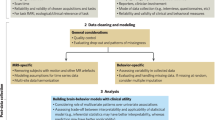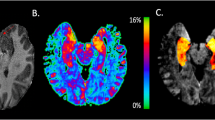Abstract
Traditionally, discussion about neuroimaging focuses on methodological improvement and neurobiological findings. In current psychiatric neuroimaging, the research focus broadens and includes concepts such as the self, personality, well-being, and psychiatric disease. This calls for the inclusion of disciplines like psychology and philosophy in a dialogue with neuroscience. Furthermore, it raises the question of how theories from these areas relate to neuroimaging findings: are results generated by objective data independent of theories? Is there an epistemological priority for the theories used for generating hypotheses and for interpreting the results? Or do theoretical concepts and neuroimaging data influence each other? In this paper, we will discuss these positions concerning the priority of concepts and data in neuroimaging and provide arguments for an interdependence of concepts and data. An awareness of these considerations may help professionals from the life sciences and humanities as well as laypersons to avoid misunderstandings and oversimplifications.
Zusammenfassung
Da breit angelegte und oft unscharf definierte theoretische Konzepte wie „Persönlichkeit”, „Selbst”, „subjektives Wohlergehen” und auch der psychiatrische Krankheitsbegriff im Zentrum der Fragestellungen psychiatrischer Forschung stehen, muss sich auch die bildgebende Forschung in der Psychiatrie obligat mit ihnen befassen. Während die Diskussion in den Neurowissenschaften traditionell hauptsächlich auf methodische und neurobiologische Aspekte fokussiert ist, werden daher für die Interpretation von Ergebnissen aus der aktuellen bildgebenden Forschung auch psychologische und philosophische Theorien benötigt. Dies wirft Fragen über die epistemiologische Bedeutung der Bildgebungsbefunde und der bei der Interpretation zu Grunde gelegten Theorien auf: Erzeugen die Methoden objektive Ergebnisse, die unabhängig von den eingesetzten Theorien sind? Existiert eine epistemiologische Priorität der Theorien, die für Hypothesenbildung und Dateninterpretation angewandt werden? Beeinflussen sich Theorien und Daten gegenseitig? In der vorliegenden Arbeit werden wir die genannten Positionen diskutieren und Argumente für eine gegenseitige Abhängigkeit zwischen Bildgebungsdaten und theoretischen Konzepten liefern. Ein Zugang zu den Neurowissenschaften, der bezüglich dieses Zusammenhanges sensibilisiert ist, könnte Wissenschaftlern in den Lebens- und Geisteswissenschaften, aber auch Laien helfen, Fehlinterpretationen und zu starke Vereinfachungen zu vermeiden.
Résumé
Les spécialistes de l’imagerie cérébrale s’intéressent, traditionnellement, aux avancées méthodologiques et aux découvertes en neurobiologie. En psychiatrie moderne, la recherche en neuro-imagerie inclut des concepts tels que la personnalité, le soi, le bien-être et la maladie mentale. Il est donc nécessaire d’établir un dialogue interdisciplinaire associant des spécialités telles que la psychologie et la philosophie avec les neurosciences. De plus, certaines questions sur la relation entre ces théories et les découvertes en neuro-imagerie émergent: Les résultats obtenus scientifiquement sont-ils bien objectifs et indépendant des théories? Y a t’il une priorité épistémologique des théories influençant la conception d’hypothèses et l’interprétation des résultats? Les concepts théoriques et les données en imagerie cérébrales s’influencent-elles mutuellement? La présente étude évalue divers points de vue sur la priorité entre les concepts théoriques et les données en neuro-imagerie et apporte des arguments en faveur de l’idée d’une interdépendance entre les deux. Une prise de conscience de ces considérations peut aider les professionnels des sciences humaines, mais aussi les néophytes, à éviter des malentendus et des simplifications outrancières.



Similar content being viewed by others
Explore related subjects
Discover the latest articles and news from researchers in related subjects, suggested using machine learning.References
Albus JS, Bekey GA, Holland JH, Kanwisher NG, Krichmar JL, Mishkin M, Modha DS, Raichle ME, Shepherd GM, Tononi G (2007) A proposal for a decade of the mind initiative. Science 317:1321 10.1126/science.317.5843.1321b
Bush GHW (1990) Proclamation “Decade of the brain”, 1990–2000, Proclamation 6158. Federal Register 55(140):29553
Calhoun VD, Adali T, Pearlson GD, Pekar JJ (2001) Spatial and temporal independent component analysis of functional MRI data containing a pair of task-related waveforms. Hum Brain Mapp 13:43–53 10.1002/hbm.1024
Callicott JH, Egan MF, Mattay VS, Bertolino A, Bone AD, Verchinksi B, Weinberger DR (2003a) Abnormal fMRI response of the dorsolateral prefrontal cortex in cognitively intact siblings of patients with schizophrenia. Am J Psychiatry 160:709–719 10.1176/appi.ajp.160.4.709
Callicott JH, Mattay VS, Verchinski BA, Marenco S, Egan MF, Weinberger DR (2003b) Complexity of prefrontal cortical dysfunction in schizophrenia: more than up or down. Am J Psychiatry 160:2209–2215 10.1176/appi.ajp.160.12.2209
Desmond JE, Annabel Chen SH (2002) Ethical issues in the clinical application of fMRI: factors affecting the validity and interpretation of activations. Brain Cogn 50:482–497 10.1016/S0278-2626(02)00531-6
Evers K (2007) Towards a philosophy for neuroethics. An informed materialist view of the brain might help to develop theoretical frameworks for applied neuroethics. EMBO Rep 8(Spec No):48–51
Fleck L (1980) Entstehung und Entwicklung einer wissenschaftlichen Tatsache. Einführung in die Lehre vom Denkstil und Denkkollektiv. Suhrkamp Verlag, Frankfurt/M
Friston KJ, Holmes AP, Worsley KF, Poline JB, Frith CD, Frackowiak RSJ (1995) Statistical parametric maps in functional imaging: a general linear approach. Hum Brain Mapp 2:189–210 10.1002/hbm.460020402
Friston KJ, Harrison L, Penny W (2003) Dynamic causal modelling. Neuroimage 19:1273–1302 10.1016/S1053-8119(03)00202-7
Fuchs T (2006) Ethical issues in neuroscience. Curr Opin Psychiatry 19:600–607 10.1097/01.yco.0000245752.75879.26
Fugelsang JA, Stein CB, Green AE, Dunbar KN (2004) Theory and data interactions of the scientific mind: evidence from the molecular and the cognitive laboratory. Can J Exp Psychol 58:86–95
Fusar-Poli P, Broome MR (2006) Conceptual issues in psychiatric neuroimaging. Curr Opin Psychiatry 19:608–612 10.1097/01.yco.0000245750.98749.1b
Goldman-Rakic PS (1994) Working memory dysfunction in schizophrenia. J Neuropsychiatry Clin Neurosci 6:348–357
Huber L (2009) Imaging the brain: visualising “pathological entities”? Searching for reliable protocols within psychiatry and their impact on the understanding of psychiatric diseases. Poiesis Prax 6 (1/2). doi:10.1007/s10202-008-0055-1
Huber CG, Kummer C, Huber J (2008) Imaging and imagining: current positions on the epistemic priority of theoretical concepts and data in psychiatric neuroimaging. Curr Opin Psychiatry 21:625–629 10.1097/YCO.0b013e328314b7a1
Illes J (2007) Empirical neuroethics. Can brain imaging visualize human thought? Why is neuroethics interested in such a possibility? EMBO Rep 8(Spec No):57–60
Illes J, Bird SJ (2006) Neuroethics: a modern context for ethics in neuroscience. Trends Neurosci 29:511–517 10.1016/j.tins.2006.07.002
Illes J, Kirschen M (2003) New prospects and ethical challenges for neuroimaging within and outside the health care system. AJNR Am J Neuroradiol 24:1932–1934
Illes J, Racine E (2005) Imaging or imagining? A neuroethics challenge informed by genetics. Am J Bioeth 5:5–18
Illes J, Kirschen MP, Gabrieli JD (2003) From neuroimaging to neuroethics. Nat Neurosci 6:205 10.1038/nn0303-205
Jansma JM, Ramsey NF, van der Wee NJ, Kahn RS (2004) Working memory capacity in schizophrenia: a parametric fMRI study. Schizophr Res 68:159–171 10.1016/S0920-9964(03)00127-0
Kaposy C (2008) Ethical muscle and scientific interests: a role for philosophy in scientific research. Q Rev Biol 83:77–86 10.1086/529565
Kell DB, Oliver SG (2004) Here is the evidence, now what is the hypothesis? The complementary roles of inductive and hypothesis-driven science in the post-genomic era. Bioessays 26:99–105 10.1002/bies.10385
Logothetis NK (2008) What we can do and what we cannot do with fMRI. Nature 453:869–878 10.1038/nature06976
Lucignani G, Nappi G (2007) Neuroimaging technology and philosophy: a coming of age? Funct Neurol 22:181–183
Manoach DS (2003) Prefrontal cortex dysfunction during working memory performance in schizophrenia: reconciling discrepant findings. Schizophr Res 60:285–298 10.1016/S0920-9964(02)00294-3
Ogawa S, Lee TM, Kay AR, Tank DW (1990) Brain magnetic resonance imaging with contrast dependent on blood oxygenation. Proc Natl Acad Sci USA 87:9868–9872 10.1073/pnas.87.24.9868
Otto TD, Meyer-Bäse A, Wismüller A, Auer D (2003) Model-free functional MRI analysis using transformation-based methods. Proc SPIE 5102:156–167 10.1117/12.487368
Peterson BS (2003) Conceptual, methodological, and statistical challenges in brain imaging studies of developmentally based psychopathologies. Dev Psychopathol 15:811–832 10.1017/S0954579403000385
Poline JB, Strother SC, Dehaene-Lambertz G, Egan GF, Lancaster JL (2006) Motivation and synthesis of the FIAC experiment: reproducibility of fMRI across expert analyses. Hum Brain Mapp 27:351–359 10.1002/hbm.20268
Popper K (1979) Truth, rationality and the growth of scientific knowledge. Vittono Klostermann, Frankfurt/M
Prasad A (2007) The (amorphous) anatomy of an invention: the case of magnetic resonance imaging (MRI). Soc Stud Sci 37:533–560 10.1177/0306312706075334
Racine E, Bar-Ilan O, Illes J (2005) fMRI in the public eye. Nat Rev Neurosci 6:159–164 10.1038/nrn1609
Roebroeck A, Formisano E, Goebel R (2005) Mapping direct influence over the brain using Granger causality and fMRI. Neuroimage 25:230–242 10.1016/j.neuroimage.2004.11.017
Rosen AC, Gur RC (2002) Ethical considerations for neuropsychologists as functional magnetic imagers. Brain Cogn 50:469–481 10.1016/S0278-2626(02)00535-3
Schultz WW, van Andel P, Sabelis I, Mooyaart E (1999) Magnetic resonance imaging of male and female genitals during coitus and female sexual arousal. BMJ 319:1596–1600
Shenton ME, Dickey CC, Frumin M, McCarley RW (2001) A review of MRI findings in schizophrenia. Schizophr Res 49:1–52 10.1016/S0920-9964(01)00163-3
Stephan KE, Harrison LM, Penny WD, Friston KJ (2004) Biophysical models of fMRI responses. Curr Opin Neurobiol 14:629–635 10.1016/j.conb.2004.08.006
van de Ven VG, Formisano E, Roder CH, Prvulovic D, Bittner RA, Dietz MG, Hubl D, Dierks T, Federspiel A, Esposito F, Di Salle F, Jansma B, Goebel R, Linden DE (2005) The spatiotemporal pattern of auditory cortical responses during verbal hallucinations. Neuroimage 27:644–655 10.1016/j.neuroimage.2005.04.041
Weinberger DR, Berman KF (1988) Speculation on the meaning of cerebral metabolic hypofrontality in schizophrenia. Schizophr Bull 14:157–168
Weiskopf N, Sitaram R, Josephs O, Veit R, Scharnowski F, Goebel R, Birbaumer N, Deichmann R, Mathiak K (2007) Real-time functional magnetic resonance imaging: methods and applications. Magn Reson Imaging 25:989–1003 10.1016/j.mri.2007.02.007
Wustenberg T, Giesel FL, Strasburger H (2005) Methodological principles for optimising functional MR experiments. Radiologe 45:99–112 10.1007/s00117-004-1164-z
Acknowledgments
An earlier version of this work was presented at the interdisciplinary summer school, “The Impact of Current Developments in the Neurosciences on the Concept of Psychiatric Disease”, that was held in Bonn, Germany, from 2nd to 9th October 2007. The author wishes to express his thanks to Dr. med. Felix Thiele, M.Sc. (Europäische Akademie zur Erforschung von Folgen wissenschaftlich-technischer Entwicklungen GmbH, Bad Neuenahr-Ahrweiler, Germany) and Dr. med. Barbara Hawellek (Department of Psychiatry and Psychotherapy, University Hospital, Bonn) for organizing this excellent summer school, to his fellow participants for the fruitful discussions and to the German Federal Ministry of Education and Research (BMBF) for its financial support.
Author information
Authors and Affiliations
Corresponding author
Rights and permissions
About this article
Cite this article
Huber, C.G. Interdependence of theoretical concepts and neuroimaging data. Poiesis Prax 6, 203–217 (2009). https://doi.org/10.1007/s10202-009-0069-3
Published:
Issue Date:
DOI: https://doi.org/10.1007/s10202-009-0069-3




